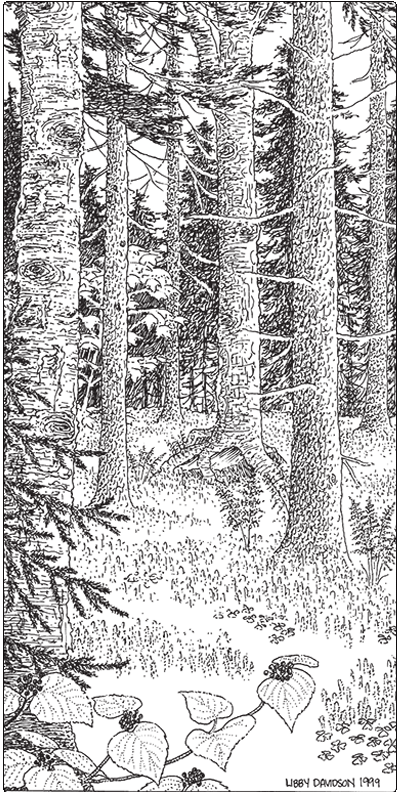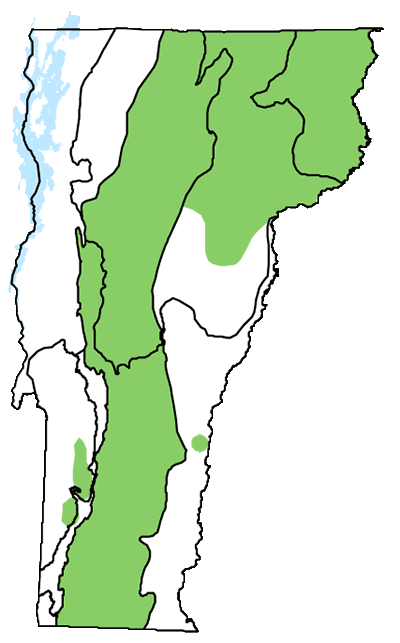Ecology and Physical Setting
On mountain slopes and low summits, this forest type characterizes the transition from Northern Hardwood Forest to Montane Spruce-Fir Forest. It ranges from 2,000 feet to 2,900 feet elevation, but the actual elevation at which it occurs varies from north to south in the mountains. In the Northern Green Mountains, 2,500 feet is the upper limit, whereas it may reach 2,900 feet in the Taconics.
In general, soils are well drained to moderately well-drained, and bedrock is often close to the surface or even exposed. Parent material is till over bedrock. Restricting layers sometimes limit the downward movement of water. There is great variability within this community; locally wet sites are common, and coves and benches can support more nutrient-demanding species.
Natural ecological processes influencing these forests include wind, ice loading, landslides, and smaller scale downslope movement of soil and nutrients.
Vegetation
At higher elevations, yellow birch and red spruce are codominant. At lower elevations, sugar maple, red maple, and American beech join the mix. Paper birch, pin cherry, and yellow birch are common in early-successional examples. Balsam fir can be present at high elevations. The understory vegetation varies depending upon the composition of the canopy and the local soil conditions. In spruce- dominated areas, the understory vegetation is quite sparse due to the dense shade created by the canopy.
Characteristic shrubs are hobblebush, striped maple, and mountain maple. Hobblebush can form nearly impenetrable thickets with its arching stems that root at the nodes. Characteristic herbs are mountain wood fern, common wood sorrel, twinflower, bluebead lily, Canada mayflower, intermediate wood fern, whorled aster, and sarsaparilla. In some places, mountain wood fern can be extremely abundant, seeming almost to exclude other species.
Wildlife Habitat
As one of our matrix forest types, Montane Yellow Birch-Red Spruce Forest covers large areas of Vermont’s upper mountain slopes. These mixed forests are mostly intact and unfragmented. They support many breeding birds, including Blackburnian warbler, black-throated green warbler, Canada warbler, Swainson’s thrush, blue-headed vireo, and northern goshawk. American marten uses mature examples of these forests in the Northeastern Highlands and Southern Green Mountains.
Successional Trends
Succession in Montane Yellow Birch-Red Spruce Forests can be set back by landslides, by treefall due to wind, or by human activities such as logging or road building. Early-successional species can include balsam fir, yellow birch, paper birch, and where organic matter has been scraped or burned off the soil, pin cherry and aspen. Over time red spruce becomes abundant and yellow birch remains an important canopy component.
Variants
- Montane Yellow Birch-Sugar Maple-Red Spruce Forest is found at lower elevations (below 2,500 feet), where sugar maple, red maple, and beech become common in the canopy. Pockets of additional moisture favor sugar maple and may account for some of these specialized pockets, which are sometimes adjacent to seeps. The hardwood trees tend to be low in stature and gnarled. Typical herbs are bladder sedge, drooping woodreed, wood millet, and in moister places, pale touch-me-not and wood nettle.
Related Communities
- Montane Spruce-Fir Forest: Red spruce and balsam fir are more abundant in these forests, which generally occur over 2,500 feet.
- Red Spruce-Northern Hardwood Forest occurs at lower elevations (often directly below Montane Yellow Birch-Red Spruce Forest) and has a greater diversity of tree species. In addition to red spruce and yellow birch, common trees include sugar maple, red maple, and beech.
Conservation Status and Management Considerations
Most of this widespread forest is maturing and developing structural complexity, and there are several old forest examples. Many areas were logged in the past. Present threats include glade cutting for skiing, and mountaintop development.
Distribution/Abundance
This community is common on upper mountain slopes in Vermont, in the Northern Green Mountains, Southern Green Mountains, Taconic Mountains, Northern Vermont Piedmont, and Northeastern Highlands. It is also common throughout the mountainous areas of the northeastern United States and southeastern Canada.
Characteristic Plants
Trees
Abundant Species
Red spruce – Picea rubens
Yellow birch – Betula alleghaniensis
Occasional to Locally Abundant Species
Sugar maple – Acer saccharum
American beech – Fagus grandifolia
Red maple – Acer rubrum
Balsam fir – Abies balsamea
Early-successional Species
Paper birch – Betula papyrifera
Pin cherry – Prunus pensylvanica
Quaking aspen – Populus tremuloides
Shrubs

or logs, resulting in elevated roots as the tree matures and the
stump rots away.
Abundant Species
Hobblebush – Viburnum lantanoides
Striped maple – Acer pensylvanicum
Mountain maple – Acer spicatum
Herbs
Abundant Species
Mountain wood fern – Dryopteris campyloptera
Common wood sorrel – Oxalis montana
Bluebead lily – Clintonia borealis
Canada mayflower – Maianthemum canadense
Sarsaparilla – Aralia nudicaulis
Occasional to Locally Abundant Species
White mandarin – Streptopus amplexifolius
Pale touch-me-not – Impatiens pallida
Twinflower – Linnaea borealis
Intermediate wood fern – Dryopteris intermedia
Bladder sedge – Carex intumescens
Drooping woodreed – Cinna latifolia
Whorled aster – Oclemena acuminata
Painted trillium – Trillium undulatum
False hellebore – Veratrum viride
Wood millet – Milium effusum
Rare and Uncommon Plants
Showy mountain ash – Sorbus decora
Mountain sweet cicely – Osmorhiza berteroi
Northern sweet cicely – Osmorhiza depauperata
Small-flowered woodrush – Luzula parviflora
Associated Animals
Snowshoe hare – Lepus americanus
Smoky shrew – Sorex fumeus
Northern flying squirrel – Glaucomys sabrinus
Moose – Alces americanus
Blackpoll warbler – Setophaga striata
Black-throated green warbler – Setophaga virens
Blackburnian warbler – Setophaga fusca
Canada warbler – Cardellina canadensis
Winter wren – Troglodytes hiemalis
Swainson’s thrush – Catharus ustulatus
Blue-headed vireo – Vireo solitarius
Ruffed grouse – Bonasa umbellus
Barred owl – Strix varia
Rare and Uncommon Animals
American marten – Martes americana
Long-tailed shrew – Sorex dispar
Northern goshawk – Accipiter gentilis
Places to Visit
Camel’s Hump, Duxbury and Huntington, Camel’s Hump State Park, Vermont Department of Forests, Parks, and Recreation (VDFPR)
Mount Mansfield, Cambridge and Underhill, Mount Mansfield State Forest, VDFPR
Equinox Highlands (Mount Equinox and Mother Myrick Mountain), Manchester, Equinox Preservation Trust, and The Nature Conservancy
Averill Mountain, Norton, Averill Mountain Wildlife Management Area, Vermont Fish and Wildlife Department
